The cactus family (Cactaceae) is a fascinating world of bright flowers and spiny stems, ranging from tiny plants to the huge desert giants. Cactuses are a good choice for people who don’t have a lot of time or experience to devote to plant care. Cacti aren’t just for deserts. You can enjoy these spiny and interesting plants as indoor potted plants regardless of your climate. Cactus plants fall into two main varieties: The spiny, bulbous kinds most associated with desert landscape and the segmented, flowering tropical types.
All cacti have flowers. Generally, cactus flowers are short-lived and provide the primary characteristics that separate cacti from other succulents. Cacti flowers have at least 10 petals, with the sepals combined with the petals, and have numerous stamens surrounding a multi-lobed stigma. If a succulent doesn’t produce a flower, it is not a cactus.
- Christmas cactus (Schlumbergera truncata)
- Barrel cactus (Echinocactus grusonii)
- Fairy Castle Cactus (Acanthocereus tetragonus)
- Star cactus (Astrophytum asterias)
- Peanut Cactus (Echinopsis chamaecereus)
- Thanksgiving cactus (Schlumbergera truncata)
- Orchid cactus (Epiphyllum ssp)
- Prickly pear Optunia cactus
- Ball Cactus (Parodia magnifica)
- Hedgehog cactus (Echinocereus engelmannii)
- Tarantula Cactus (Cleistocactus Winteri)
- Powder Puff Cactus (Mammillaria bocasana)
- Sulcorebutia Cactus (Sulcorebutia canigueralii)
- Bishop’s Hat Cactus (Astrophytum myriostigma)
- Monk’s Hood Cactus (Astrophytum ornatum)
- Fishhook Cactus (Mammillaria microcarpa)
- Chin Cactus (Gymnocalycium ssp)
- Mexican Fire Barrel Cactus
- Starfish Cactus (Stapelia hirsuta)
- Ladyfinger Cactus (Mammillaria elongata)
- Beavertail Cactus (Opuntia basilaris)
- zig-zag cactus (Selenicereus anthonyanus)
- Silver Torch Cactus (Cleistocactus strausii)
- Horse crippler cactus (Echinocactus texensis)
Christmas Cactus

The Christmas cactus is most often grown as a houseplant and blooms in a wide range of colors from the traditional red to purple, pink, orange, gold and white. But they aren’t named for their festive red-and-green colors. Instead, Christmas cactuses earn their common name from the fact that they bloom right around the holidays. In fact, their arching branches, tipped with red, pink, white or purple flowers lend themselves well to hanging baskets.
Golden barrel Cactus

Golden barrel cactus has yellow spines and a symmetrical shape that elongates as it matures.This type of cactus typically measures more than 5 inches across and is less than 10 times as tall as it is wide and is one of the most widely cultivated varieties. Although barrel cacti may look mundane throughout the year with their basic green bodies and variable spine colors. In spring, bright yellow flowers emerge from the white, wooly crown of the stem. Blooming periods for the barrel cactus range broadly based on local environmental conditions.
Fairy castle cactus

Fairy Castle Cacti are slow-growing type of cacti but revered for their beauty. Each stem has five sides and is lined with small white, wooly spines that grow along the edges of their height.The stems are vibrant green in color but will brown with time in a process called corking. These can grow up to 6 feet tall, and they occasionally produce large white flowers but only at night.
Star Cactus
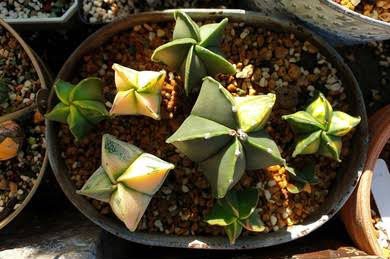
At maturity, Star cactus plant stands approximately three inches tall and six inches wide. Its ribbed structure gives the cactus its star-like shape with eight triangular sections surrounding woolly areoles. Grayish-brown in color, the star cactus is covered in white dots. The plant has yellow flowers with orange centers that typically bloom during spring throughout summer.
Also Read: Desert Accent Plants
Peanut Cactus

Peanut cactus is most suited to container growing because it is a small, low-growing cactus that tends to get lost in the landscape. Small white bristly spines clothe the six to nine ridges along the stems, suggesting the lines down the outside of a peanut shell. The 1/2-inch-wide stem joints tend to be about the size of an unshelled peanut as well, giving it its common name. New growth is erect to begin with, up to 4 inches tall, but then stems crawl along the soil. Old stems become brown and woody. The plants flower when young, producing funnel-shaped 2-inch-wide and 3-inch-long bright orange flowers.
Thanksgiving Cactus

Thanksgiving cactus is a popular tropical cactus that is sold around the holidays for its gorgeous and prolific flowers. As its common name indicates, the Thanksgiving cactus is known for blooming around Thanksgiving, bringing a splash of color into your home just as the weather outdoors is getting colder. The flowers that appear in fall are similar to fuchsia blooms and come in hues of yellow, white, pink, and red.
Orchid Cactus

Epiphyllum is a genus of tropical succulents often referred to as orchid cacti or climbing cacti. There are over a dozen species and many associated hybrids of varying shapes and sizes. They usually have long, flat, non-spiny, and trailing stems. With the right care, they showcase bright, large, fragrant, and night-blooming flowers in the spring or summer. In the wild, these mostly epiphytic plants grow on branches or trunks of trees rather than developing roots in the ground. These plants require patience to grow, as their blooms only show their faces for two or three days a year before fading into the graceful greenery.
Prickly pear cactus

The name “prickly pear” refers to species of the cactus genus Opuntia and also to the fruits these cacti produce. They produce paddle- or cylinder-like leaves, and the fruit of many species are edible and used in making jellies, juices and candies. Depending on the species, the 3/4-inch-thick, elliptical or oblong prickly pear pads grow 9 inches wide and from 4 to 16 inches long. Most cultivated species are spineless or contain single 1-inch-long white spines. Pickly pear cactus varieties range in size from small ground covers to tree-sized specimens, all bearing bright yellow to red flowers.
Also Read: Plants That Grow Well In Terrariums
Ball Cactus

Ball cactus is magnificent in appearance especially when grow in pots or containers. Their round appearance is to credit for their shapely name, and they can grow in pots in clusters up to over a foot wide. Ball cacti are moderate growers, adding about 4 inches to their height each year. Older plants will frequently produce flowers in beautiful shades of yellow, red, orange, or pink, and all varietals feature ridges of spikes that start white and grow to a yellow-brown with age.
Hedgehog cactus
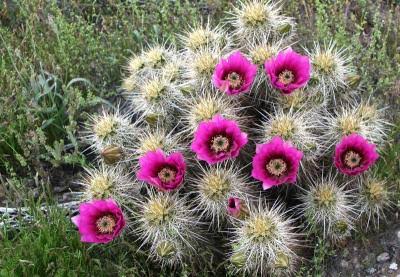
Also referred to as Engelmann’s hedgehog cactus, named for the botanist and physician George Engelmann.This cactus grows in clumps of three to 60 stems per clump. Each light green stem grows up to 12 inches tall. As more and more stems grow, the clump can spread to 3 feet wide. The stems are cylindrical bodies with 11 to 14 ribs.The most common hedgehog-cactus varieties have intense magenta flowers, although the flowers may also appear in shades of pink, purple and lavender. The blossoms last for five days, opening in the morning and closing at night. Hedgehog-cactus flowers are up to 3 inches wide, making them look quite large in comparison to the size of the stems.
Tarantula cactus

The tarantula cactus plant (Cleistocactus winteri) is one of the most distinctive in appearance. It produces numerous stems that trail down from the crown of the plant, covered in golden hairs. In spring, the plant will yield salmon colored flowers with rayed petals. The blooms are 2.5 inches across and brilliant against the golden stems. This variety of cactus makes an eye-catching display in a hanging planter. Along with the spiny hairs, it also produces spun white hairs that resemble cobwebs.
Powder Puff Cactus

Powder puff cactus grows rapidly and produces small round offsets, which cluster around the parent plant. Mammilaria powder puffs will produce small white or red flowers depending on the cultivar grown. The body of the cactus is bluish green, stocky, and made up of short stems that hug the ground. The entire plant is covered in silky white hairs that cover the red or yellow curved spines that also coat the entire cactus.
Also Read: Different Types of Marigold Flowers
Bishop’s Hat Cactus
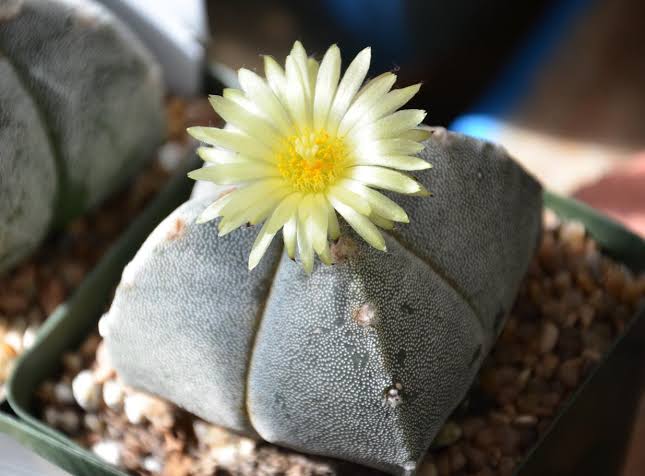
Bishop’s hat cactus is a spineless cactus defined by the presence of three to seven (usually five) pronounced vertical ribs which define the cactus’ shape when young, As the cactus ages, more ribs may be added and it becomes more cylindrical in shape. Daisy-like flowers bloom on the mature Bishop’s Cap, yellow with a red to orange center. While each flower lasts just a couple of days, they bloom in succession and flowers may be present for an extended time. The beautiful blooms are slightly fragrant and just another good reason to grow this beautiful plant.
Monk’s hood cactus

Astrophytum ornatum is a cylindrical to columnar cactus from the Cactaceae family. It forms between 6-8, light green ribs and may have a spiralling habit, typically growing to around 35cm in height outside of its native habitat. This species of cactus will grow into an elongated columnar shape with deep ribs. It will bear large, showy, pale yellow flowers in the summer and autumn.
Chin cactus

Gymnocalycium baldianum (chin cactus) is a semi-flattened globular dark green, species with appressed spines along shallow ribs. It also produces absolutely dynamite flowers. They’re 1.5 inches in diameter and can be white, light pink, red, hot pink, or even coral or salmon.
Starfish Cactus

Starfish cactus is a soft stemmed plant without spines spreading out from a central point. They are thickly skinned and resemble carrion flesh. Starfish flower cactus may produce amazing five-petaled flowers that exude a rather unpleasant odor. The scent attracts flies and other insects, which pollinate the blooms. Flowers are red to brown and may be mottled with a couple of colors.
Also Read: Different Types of Agapanthus Varieties
Beavertail cactus
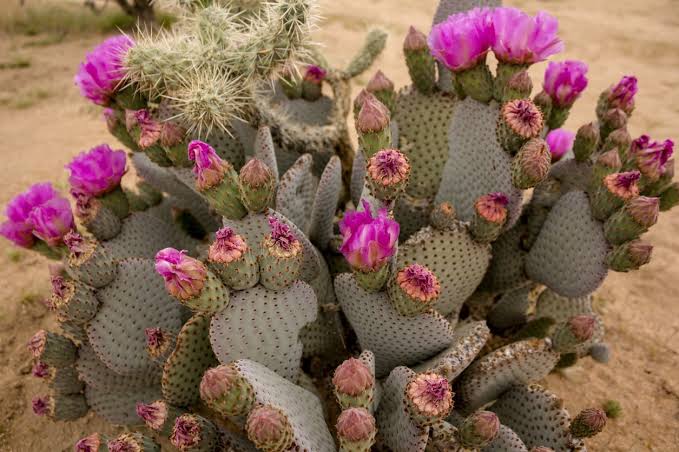
The beavertail cactus or beavertail pricklypear is a low, spreading cactus with short bristles grows 6 to 12 inches high and up to 6 feet wide. The gray-green, jointed stems are wide and flat resembling the tail of a beaver. val in shape, the stems are 1 to 6 inches wide and 2 to 13 inches long. The stems grow in clumps with flowers from the top edge of the joints. Flowers are followed by a brownish-gray, oval fruit more than an inch long with many seeds.
Fishhook Cactus

Fishhook is a low, cylindrical cactus with one or many thick-clustered stems grows to 6 inches high. Many hooked spines, 1/2-inch long at the tips of the cactus, are surrounded by numerous, straight, tan-to-pink ones. The Fishhook Cactus has extended, smooth, red fruit 1/2 to 1 inches long.
Cholla Cactus

Most cholla cactus have orange or greenish-yellow flowers with a variety of colors, even among the same species. Most species bloom April through June, depending on local conditions. Stems and joints vary in width, length, shape, and color, as well as in the profusion of spines and glochids. Chollas may appear as ground creepers, shrubs or trees, varying in height from less than a foot to as much as 15 feet.
Lady Finger Cactus
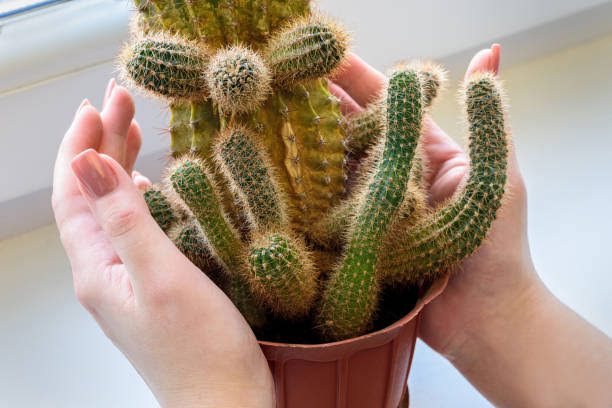
The Lady Finger Cactus also sometimes known as Golden Stars, Gold Lace Cactus or simply Lady Fingers has stems that can reach up to 6 inches in length and average just over an inch in diameter. The stems are covered in white or gold recurved spines.The Lady Finger Cactus is a clumping cactus that grows in tight clusters.In spring, the Lady Finger Cactus produces petite white, yellow, or pink flowers. The flowers are sometimes solid in color, but they may also flush pink or have pink stripes. The blooms emerge from the axils of the cactus’ tubercles.
Also Read: Hanging Plants For Indoor Spaces
Silver Cactus
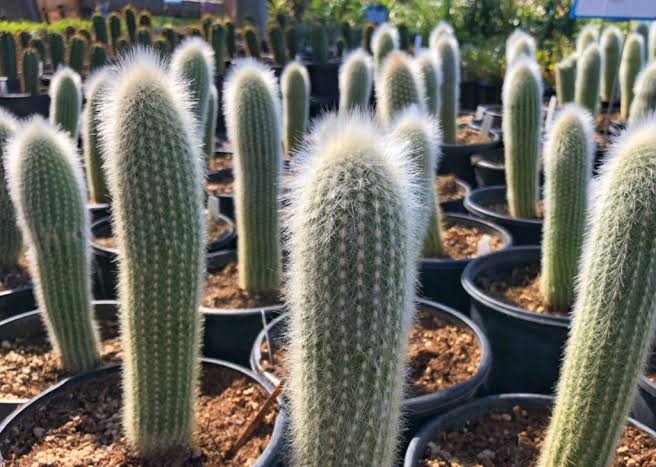
This striking cactus develops slender columns up to eight to ten feet tall. It is a vigorous grower that has interesting, silvery blue spines on hairy, bluish-gray columns. The silver torch begins to flower when the columns reach about eighteen inches tall. The decorative flowers are deep red or burgundy and protrude from the sides of the columnar stems and along the tips.
Horse crippler cactus
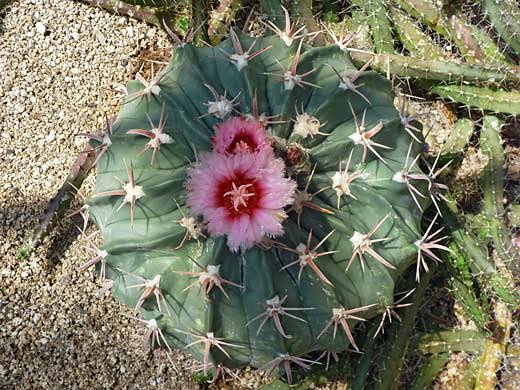
Horse Crippler is an attractive, stout barrel cactus, which solitary when young and very rarely slowly clustering in age. The stem is pale grey-green to grass green with numerous ribs, above-ground portion, flat-topped, hemispheric in old age but usually deep-seated, flush with soil surface 30 cm in diameter, 20 cm tall. The spines are small but strong, pale tan, pink or reddish to grey. The flowers are range from white through rose-pink to pale silvery-pink, with red throats in late spring and can appear on plants around 10cm in diameter.
Zig-zag Cactus
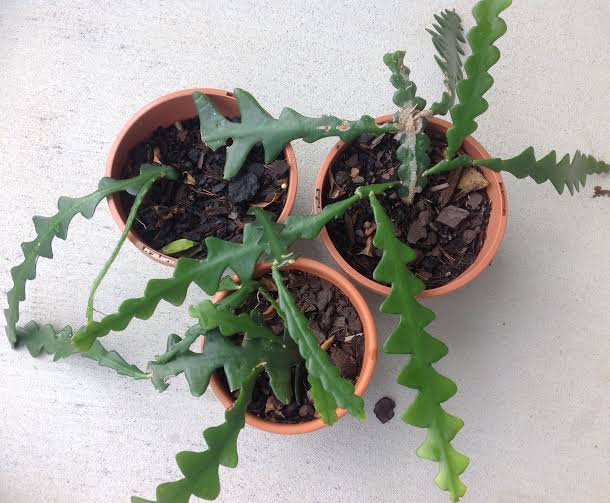
Zig-zag cactus is a fast growing epiphytic scandent or climbing cactus that branches along a notched narrow stem and produces 2 to 3 foot long green 3 to 4 inch wide flat branches that have nearly 2 inch long by half inch wide lobes that are tapered towards a rounded apex so appear to be a pinnate leaf. The stems can adhere to porous surfaces and often have a few aerial roots. The large showy fragrant flowers appear in late spring and early summer and are open in late afternoon and evening, lasting only one day. The outer petals that are a dark violet rose color with white inner petals, yellow stamens and a prominent white branched pistil in the center.
Further References
- Facts About Cactus: https://en.m.wikipedia.org/wiki/Cactus
- Best Cactus For Growing In The Garden: https://www.thespruce.com/best-cactus-to-plant-in-garden-4059807
- Cactus To Grow At Home: https://www.countryliving.com/gardening/g28365636/types-of-cactus-species/
- Cactus Garden Ideas: https://www.trees.com/gardening-and-landscaping/cactus-garden-ideas